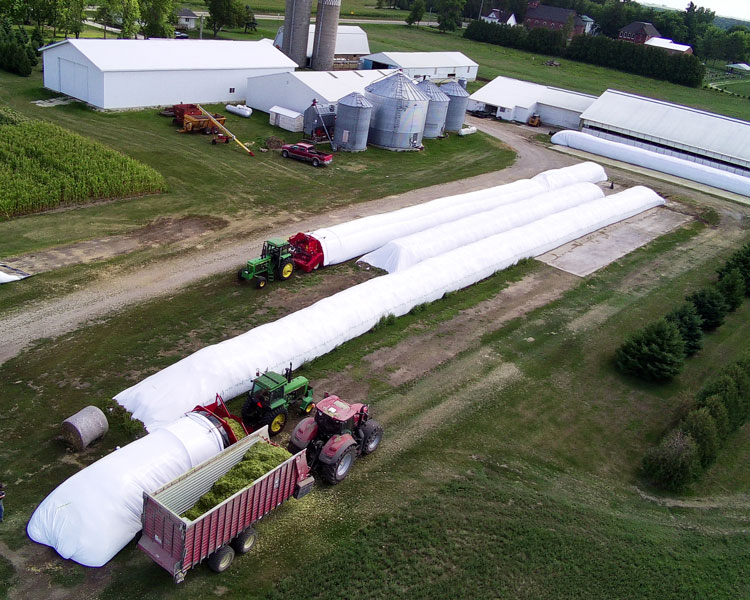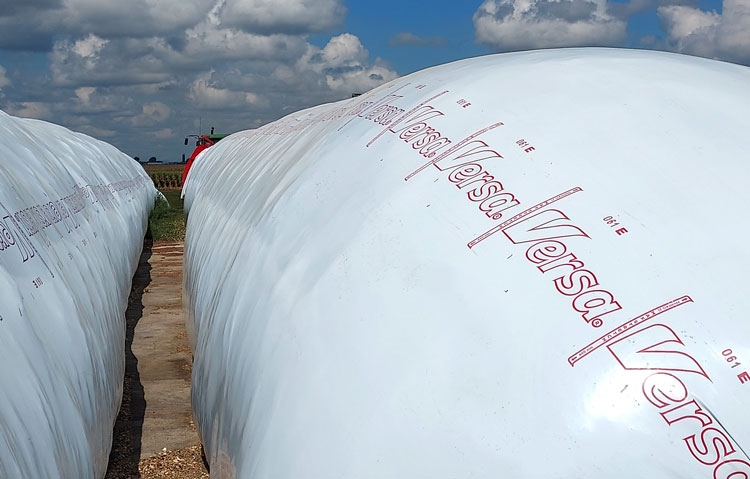
For dairy farmers, “good feed promotes good production” is a guiding principle that has a direct cause-and-effect impact on milk tank volume. As a result, providing the highest quality feed is crucial and significantly affects a dairy’s bottom line, surpassing any other operational change in terms of expense.
“You can see an immediate increase in production with better feed,” says Kyle Rauls of Rauls Dairy in DeForest, WI. “If you get into a better feed, [the cows] start milking better within days. If the feed is moldy, some cows will go off the feed and drop weight on milk.”
Given the importance, experienced dairy farmers closely monitor milk production and herd health daily to assess the effectiveness of the feed and make any needed adjustments to the Total Mixed Ration (TMR) fed to dairy cows.
The process typically involves creating on-farm silage and mixing it in appropriate proportions into the TMR along with other additives. As a home-grown food source, silage is a cost-effective and sustainable way to provide dairy cattle with many of the nutrients and calories they need to stay healthy and productive.
Silage bagging also plays a role in helping reduce the emission of volatile organic compounds (VOCs) associated with dairy farming practices. By minimizing open face exposure to the environment and reducing spoilage, silage bagging can assist in meeting potentially stricter EPA regulations expected in the near future.
Silage Waste
One of the main obstacles in producing silage using conventional methods like piles, pits, and bunkers is the considerable risk of spoilage and loss, which can amount to as much as 30%.
The problem with these conventional methods is the excessive exposure to oxygen, which leads to rapid deterioration of silage. Proper packing of silage is crucial to effectively preserve it. Insufficient packing, which fails to minimize oxygen exposure, can result in spoilage of ensiled dry matter, and lead to feed loss.
With silage bagging, the oxygen is removed almost instantly, and fermentation begins promptly. The sealed bags protect silage quality and maintain favorable fermentation conditions even amid unfavorable conditions such as exposure to rain, moisture, excessive dryness, or prolonged storage.

The result is higher nutrient retention per acre, increased milk production, enhanced dairy cow health, reduced veterinary costs, and improved efficiency. Additionally, bagging enables better crop separation and the development of improved feed rations for cows.
“Large piles [in pits and bunkers] constantly degrade over time due to oxygen exposure. In contrast, airtight bagging encloses the silage, leaving only a small area open. This stops the continual degradation of feed quality and ensures optimal freshness and longevity,” says Steve Cullen, President, Astoria, OR-based Versa Corporation, a global leader in agricultural silage bagging and handling.
Proper Silage Bagging
According to Kyle Rauls, his dairy originally turned to silage bagging in the 1990s to improve the quality of the feed for his herd and to prevent spoilage.
According to The University of Tennessee Agricultural Extension Service report Managing Intake of Lactating Dairy Cows, “Lactating dairy cows must consume large quantities of dry matter (DM) to provide the nutrients needed to maintain high levels of milk production. The consequences of low dry matter intake (DMI) are lower peak milk yields, lower total milk production, excessive loss of body weight and poor reproductive performance. Research has shown a two pound increase in milk production for each pound increase in DMI. As milk production continues to increase, management of DMI becomes more critical.”
Today, Rauls creates corn silage, haylage, and ryelage utilizing silage bags for his farm. The silage is then mixed with proteins, minerals, and other feed additives into their TMR.
The convenience of using individual bags enables dairy farmers like Rauls, as well as nutritionists, to mark bags for identification, facilitating balanced rations and more accurate dry matter intake. With this approach, a separate TMR can be developed for different animal groups such as for fresh cows, early lactation cows, mid-and late-lactation cows, and far-off and close-up dry cows.
Over the years, Rauls has honed his silage bagging process, gradually transitioning from limited capacity to higher capacity bagging equipment. Today, Rauls bags approximately 50,000 tons of silage annually using a heavy-duty side-loader designed for forage wagons. The high-capacity Versa ID900N bagger, powered by a tractor, can be used to bag up to 12-foot diameter bags that are 500 feet long.
Rauls and his four brothers, who operate nearby dairy farms, all share time using the silage bagging equipment. Together, the family manages about 2,000 dairy cows.
As dairy farmers like Rauls have used silage bagging over the years, the equipment has continued to improve. To maximize the effectiveness of their equipment, dairy farmers should prioritize packing pressure as a key factor to consider for equipment selection, according to Rauls.
“You want to pack as much as you can airtight, so you don’t have spoilage. You don’t want air pockets in the bag because that is where you get mold,” says Rauls. “The Versa bagger packs it very well. That was one of the advantages versus the other brand we used.”
Among silage bagging equipment, packing is approached in various ways, which can affect dairy farmer productivity. Ideally, the equipment would firmly pack the bag without over-stretching it while gradually moving the machine forward as the bag fills.
Previously, Rauls utilized a cable system with a heavy net backstop. With such a system, after each bag is filled, the cables must be rewound and the backstop moved to the next location, a cumbersome process.
For greater efficiency, Versa created an innovative cable loop density system that uses a single adjustable cable inside the bag. The OEM also developed a heavy-duty belt system that facilitates tighter packing of longer silage bags than the industry norm, which minimizes air pockets and spoilage while maximizing storage capacity.
Today, the process of creating bagged silage for dairy farmers is relatively simple. Essentially, they back up a truck, dump the feed in, and start bagging. Even the largest model the OEM offers, which is capable of bagging 8-14 tons of silage per minute, can be easily transported to different sites. The Versa silage bagging machines are durable, with most still in use after over 20 years of operation.
Silage’s Environmental Benefits
There are notable environmental benefits associated with silage bagging for dairy farmers. According to one estimate, based on a review of several California diaries, more than 90% of reactive VOC emissions came from silage sources.
By minimizing spoilage, a major source of volatile organic compounds is significantly reduced. Additionally, bagging eliminates any leaching into the ground.
“Bagging silage is the best means to minimize storage shrink. This assists in both reducing nutrient and financial losses,” says Frank Mitloehner, PHD Professor and Cooperative Extension Air Quality Specialist Director, CLEAR Center Department of Animal Science University of California, Davis, CA. Mitloehner is the co-author of multiple studies on the topic of emissions from silage sources on dairy farms.
In California, dairy farmers are already required to adopt effective mitigation strategies to minimize greenhouse gas emissions, including methane, nitrous oxide, and carbon dioxide. Government-issued carbon credits can be obtained by dairy farmers for implementing measures such as utilizing digesters to control methane emissions from manure. Although carbon credits are not awarded for silage bagging, it is anticipated that this could change in the near future.
With silage essential for dairy farms, the use of silage bagging is now becoming an industry best practice over more traditional methods. Farmers who take advantage of this cost-effective, superior technology will promote the health and production of their dairy cows as well as the efficiency and profitability of their operation for many years to come.
For more information, call (800) 837-7288 or visit versacorporation.com.

